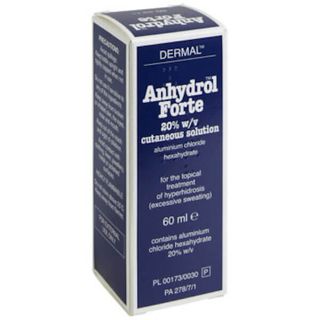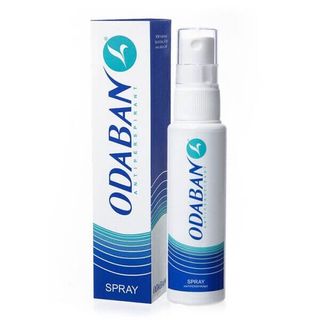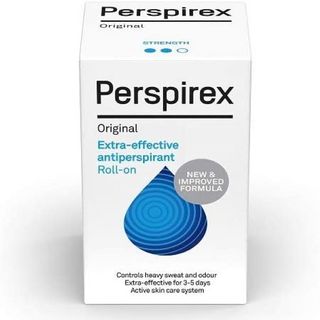
Excessive Sweating
Excessive sweating, or hyperhidrosis, can be uncomfortable and inconvenient. Some people also find the condition a little embarrassing and feel self-conscious about patches or odour. You might have excessive sweating in just one area, or it can affect your whole body. The condition isn’t normally a sign of anything serious, but we understand you’ll probably want to get your perspiration under control as quickly as possible. Wearing loose-fitting clothing and taking regular showers can help, and there are also some really effective over-the-counter antiperspirant deodorants available. Our team can help you find the solution that’s right for you.
Excessive Sweating Treatments
 Anhydrol Forte Roll-On£5.19
Anhydrol Forte Roll-On£5.19
Driclor Roll-On
Driclor Roll-On£10.49
Odaban Antiperspirant Deodorant
Odaban Antiperspirant Deodorant£13.99
Perspirex
Perspirex Medical Anti-Perspirant Deodorant£7.99
View recommended products for Excessive Sweating
Don't wait to get the medical help you need.
View our recommended treatments and select your preferred treatment and quantity from a list of options for you.
Selected by our UK-based medical team
Quick and easy checkout
Treatments dispatched same day (before 3pm)
Ordering as easy as 1, 2, 3
1. Find the ideal treatment
2. Get a free consultation
3. Enjoy speedy delivery
Advice for Excessive Sweating
What is Excessive Sweating & what causes it?
Excessive sweating is sometimes referred to as hyperhidrosis. It is a common condition that is estimated to affect 3 out of every 100 people. The condition may only affect certain areas of the body.
However, in some cases, the entire body can be affected. The most commonly affected areas are the armpits, palms of the hands, soles of the feet, the face, the chest and the groin.
Hyperhidrosis will usually affect both sides of the body – for example, it would be unusual for just one palm to be affected. In the majority of cases, excessive sweating doesn’t present any significant threat to a person’s health. However, the associated symptoms can cause embarrassment or distress, which potentially can affect an individual’s quality of life. This may result in feelings of anxiety or depression. Excessive sweating can strike at any age, although the majority of cases typically develop during childhood or not long after puberty.
There are no specific guidelines that outline what normal levels of sweating are. If a person feels that they are sweating to the extent that it is interfering with their everyday life then they may have hyperhidrosis. Examples of this interference include:
- Avoiding physical contact, such as handshakes, due to being self-conscious about excessive sweating.
- Avoiding physical activities, such as exercise or dancing, through fear of making sweating worse.
- Job interference, where it is difficult to hold tools, operate a keyboard or drive.
- Spending a significant amount of time trying to counter the sweating, for example; frequent showers or changes of clothes.
In most cases, excessive sweating has no obvious cause, though it is thought to be the result of a problem with the nervous system, specifically the part that regulates sweating. This form of excessive sweating is known as primary hyperhidrosis. Where there are identifiable causes, it is known as secondary hyperhidrosis. Secondary hyperhidrosis can be triggered for a variety of reasons, including:
- Pregnancy.
- Menopause.
- Hypoglycaemia.
- Overactive thyroid.
- Certain medicines.
- Certain types of infections.
What are the symptoms of Excessive Sweating?
The symptoms of hyperhidrosis are excessive levels of sweat being produced by the body. This usually affects key areas like the armpits, palms, soles, face, chest and groin. In certain cases, the whole body may be affected.
This excessive sweating will in most cases affect both sides of the body, for example; both feet or both armpits will secrete excessive amounts of sweat. What constitutes as excessive levels isn’t fully clear, sweat levels are usually considered excessive when it starts to interfere with everyday life, for example holding objects or driving a car.
How is Excessive Sweating diagnosed?
Most simple cases of excessive sweating can be self-diagnosed. You would only need to see your doctor in the following circumstances:
- If the symptoms of hyperhidrosis do not respond to self-treatment, it is recommended you visit your GP for an informed diagnosis.
- If you have other symptoms that may indicate that your sweating is caused by another condition (see 'Background' above).
In this instance, your doctor will in most cases, be able to diagnose the condition based solely on your symptoms. However, it may sometimes be necessary to perform blood or urine test in order to check for any underlying causes.
How can I prevent Excessive Sweating?
Sadly, lifestyle changes won’t cure hyperhidrosis. However, they can help improve the associated symptoms. The advice is outlined below:
- Avoiding known triggers, such as alcohol and spicy foods.
- Using antiperspirant rather than deodorant.
- Avoiding tight fitting clothing and artificial fibres like nylon.
- Using armpit shield to absorb the excess moisture and protect clothing.
- Wearing sports soles or sports socks that are designed to absorb moisture.
- Ideally wearing shoes made from leather.
- Alternating between different pairs of shoes on a daily basis.
How can Excessive Sweating be treated?
Initially, you should try to control your sweating using antiperspirant. If regular antiperspirants are not controlling your excessive sweating, you may wish to try a stronger one available from pharmacies. Certain antiperspirants contain aluminium chloride, which works by creating a plug in the sweat glands. An example of an antiperspirant containing aluminium chloride is Anhydrol Forte. These are usually applied at night before you go to sleep and then washed off the next morning. The most common side-effect associated with this form of treatment is a mild irritation or itching at the site of application. Using these treatments less frequently can help limit this irritation. Using emollients as a soap substitute to moisturise the area may also help.
If aluminium chloride is still not effective, you should see your doctor to discuss medicines known as anticholinergics. These medicines work by blocking the chemical acetylcholine, which is used by the nervous system to activate the sweat glands. These medicines are available in tablet form or as a topical solution that is applied to the affected area. An example of an Anticholinergic is Propantheline.
Alternatively, your doctor may refer you to a dermatologist for further treatment. This can include Iontophoresis, Botulinum toxin injections or surgery.
FAQs for Excessive Sweating
What is Excessive Sweating & Hyperhydrosis?
Sweating is a normal function of the human body. However, some people (around 1% of the population) suffer from excessive sweating - high levels of sweat that can be problematic in practical & social situations. There is no specific threshold which constitutes excessive sweating, but you may want to contact your GP and seek treatments if you find that you sweat so much as to be uncomfortable, either physically or socially.
Prolonged cases of excessive sweating without any obvious triggers are known as hyperhidrosis. It is normally limited to certain areas of the body like the face or the hands opposed to general sweating which tends to be all over the body.
What are the different kinds of Hyperhidrosis?
Hyperhidrosis is the name for severe instances of excessive sweating. Roughly one percent of the population suffers from a form of hyperhidrosis. Unlike general sweating, which can affect any or all parts of the body, this condition is limited to the underarm (axillary hyperhidrosis), hands (palmar hyperhidrosis), feet (pedal hyperhidrosis) or face (hyperhidrosis).
Some people primarily suffer from excessive sweating while asleep. This is called nocturnal hyperhidrosis. It may cause you to wake up in uncomfortable damp bedding. This most commonly affects adults going through phases of hormonal change – it is a symptom of the menopause in women and the ‘andropause’ in men.
Because the symptoms tend to be quite apparent, it is usually straightforward to diagnose each of these kinds of hyperhidrosis. However, your GP may recommend some tests to ensure that your sweating is not due to certain other conditions like an overactive thyroid.
Why does Excessive Sweating (Hyperhidrosis) occur?
The occurrence of hyperhidrosis in a person is largely unpredictable and occurs in people who are otherwise healthy, although it may get worse during particularly stressful periods. It is the result of over-active sweat glands possibly due to a problem with the sympathetic nervous system. In about 40% of cases, there is a family history of hyperhidrosis. This means there is likely a genetic contribution, though not everyone knows of a family member who suffers from this ailment.
There are some medical ailments that can cause excessive sweating. Thyroid, menopause, and anxiety can cause excessive sweating, but this perspiration will appear on the majority of the body whereas hyperhidrosis is limited to certain areas such as the hands or face. Night sweating can be a presentation of some malignant diseases or infections such as tuberculosis.
At times, however, hyperhidrosis may be a result of more severe complications such as diabetes or thyroid conditions. For this reason, you should consult your GP if you think you are sweating excessively – they may recommend some tests to rule out these conditions.
Will Hyperhidrosis last my entire life?
In most cases, hyperhidrosis is a chronic condition that tends to start during puberty and will not go away. It may become more pronounced with age, however, there are also reports of that people have suffered from excessive sweating and it disappeared later in their life. This does not mean that you will have a similar experience.
Hyperhidrosis cannot be cured, but there are several methods of treatment and lifestyle changes which can help to minimise its impact on your life.
How do I treat Excessive Sweating?
There are several options for treatment, depending on the severity of your hyperhidrosis.
The first option is an aluminium chloride antiperspirant. Driclor, Odaban, Anhydrol Forte and Perspirex are all contain 10 - 20% aluminium chloride, compared to about 5% for normal antiperspirants. Odaban tends to be especially popular because it can be sprayed on the face as well as on other areas. They work by blocking the sweat glands, preventing the release of excessive sweat. They are effective at bringing the condition under control in most sufferers.
If antiperspirants are ineffective, your doctor may advise more drastic treatments. One of these is iontophoresis, a treatment whereby an electrical current is used to reduce the activity of sweat glands. It is a painless procedure that involves placing your hands in tubs of water which are subjected to electric currents.
More commonly used in cosmetic procedures, Botox can also be effective at kerbing excessive sweating. Botox injections stop the pathways through which the sweat glands receive signals from the brain. It can prevent excessive sweating for up to four months following a treatment.
Finally, there is a surgical treatment called Endoscopic Thoracic Sympathectomy, which involves disabling the part of the nervous system responsible for excessive sweating. It is most often used to treat palmar hyperhidrosis.
What are the long-term effects of Excessive Sweating or Hyperhidrosis?
Hyperhidrosis is normally a chronic, lifelong condition starting during puberty. Hyperhidrosis usually occurs on its own, in which case it is not physically harmful and will not impact your lifespan. The harmful effects of hyperhidrosis are primarily psychological. It can be a major component of social anxiety and low self-esteem. If anxiety due to excessive sweating is having an impact on your life, consider talking to your GP about your options for treatment.
Whilst excessive sweating does not damage your health, it can have an impact on you in a psychological and emotional way. It can lead to social anxiety, low self-esteem and a lack of self-confidence. All of which can have a detrimental effect on the sufferer’s career, relationships and family life.
Excessive sweating is not usually linked to normal stimuli for sweating such as the weather, temperature or time of day. It can also be worsened by stressful situations such as interviews or social events.
Primary hyperhidrosis, that for no apparent reason, is unlikely to be due to a serious underlying health problem. However, secondary hyperhidrosis normally needs to be investigated as this type of excessive sweating can be caused by a medical condition, for example, thyroid problems or diabetes. If these are left undiagnosed they can be potentially life threatening.
You should speak to your doctor if you have any concerns about the long-term effects of excessive sweating, especially if you suspect that you may be suffering from secondary hyperhidrosis.
Do I need to change my lifestyle?
Apart from the treatments mentioned above, there are some steps you can take in your daily life which might help to minimise the amount that you sweat:
- Alcohol, caffeine, nicotine and spicy foods are known to increase the activity of sweat glands. Other foods, such as fish, onion and garlic, tend to cause sweat to be particularly odorous.
- Hair tends to both hold sweat and facilitate the growth of odour-causing bacteria. Consider shaving your armpits or other areas where you commonly notice sweat.
- Synthetic materials may cause you to sweat more. Try wearing natural fabrics.
- If you have pedal hyperhidrosis, change your socks regularly and ensure you do not have a fungal infection or excess dead skin.
- Be wary of what colour of shirt you wear, as some colours show sweat very prominently. This will not reduce the amount of sweat, but may help to reduce some of the anxiety that comes from sweat patches being visible.
Can Excessive Sweating be 'cured'?
Unfortunately at present, there is no actual cure for excessive sweating but there are several forms of treatment available which are effective at controlling the symptoms.
There isn’t a single cure but a combination of preventative methods may help to ease symptoms. Many people with this condition learn to live with it by taking steps to reduce their excessive sweating and improve their quality of life.
What is Iontophoresis?
This is another treatment for excessive sweating which uses water and electrical current as a means of shutting down the sweat glands which then reduces the amount of moisture produced.
It is a painless form of treatment which can be done at home and helps to keep your excessive sweating at bay. It requires you to place your hands in bowls of water through which an electrical current is passed. This current reacts with minerals in the water which blocks your sweat glands.